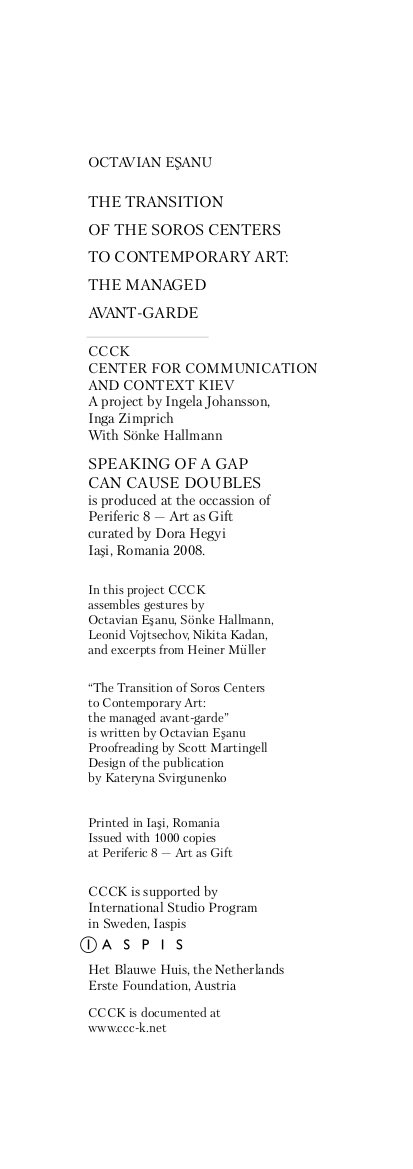Octavian Eşanu: The Transition of The Soros Centers to Contemporary Art: The Managed Avant-Garde (2008)
Filed under pamphlet | Tags: · art system, contemporary art, eastern europe, institutional critique

“As in other transitological regions of the world, in Eastern Europe, throughout the 1990s, this “neo-liberal discourse of radical reform” became a new ideology. It quickly installed itself in the vacuum left after the collapse of Marxism-Leninism, and its working postulates (directed primarily at politics and economics) soon reached into the domain of art and culture, altering not only pre-established artistic and aesthetic conventions but changing also the social status of art in the post-communist society. While in such fields as politics and economy this doctrine has been recognized and accepted from the very beginning as a legitimate discourse – prompting some scholars to call for “the end of the transition paradigm” – by contrast, in art no analysis has been done on the importance of the notion of “transition” and the impact of transitology. The effect of this paradigm on art, however, was significant. Many individual changes within art resemble the pattern of political and economic reforms to such a degree that one may infer the existence of a “cultural transitology” – a hidden managerial agenda that monitored and implemented reforms in the field of culture. One of the first points on this agenda was the transition to a Western artistic model, and this was one of the main tasks of the SCCAs. One can set a parallel and compare the role of the SCCA network with that played by such active participants in the process of transition as the International Monetary Fund (IMF) and the World Bank. While these international organizations have been concerned in such fields as economics and politics with various aspects of social transformation – disputing such issues as the conversion of planned economies into free markets, or the dissemination of liberal democratic values at the expense of other political doctrines – the SCCAs dealt mainly with the emancipation of art and culture from the ideological, political and economic control of the state. On the aesthetic level this transition was manifested in the attempt to break with the doctrine of Socialist Realism, with its aesthetic and ideological principles; artists were encouraged to work with new media whereas art historians were to write new art histories, which would evolve around the narrative of the formerly suppressed non-conformism. Economically the SCCAs provided expertise for developing local networks of Western styled private and corporate art institutions capable of accommodating to the logic of the free market. After escaping the ideological and material control of the state the centers were to help local artists adjust to a new order, devoting a good part of their efforts to cultural management and fund raising.” (excerpt)
Published by CCCK, Kyiv, at Periferic 8 “Art as Gift” Biennial for Contemporary Art in Iaşi, Romania
20 pages
PDF, PDF (updated on 2019-10-22)
Comment (0)Leave a Reply

